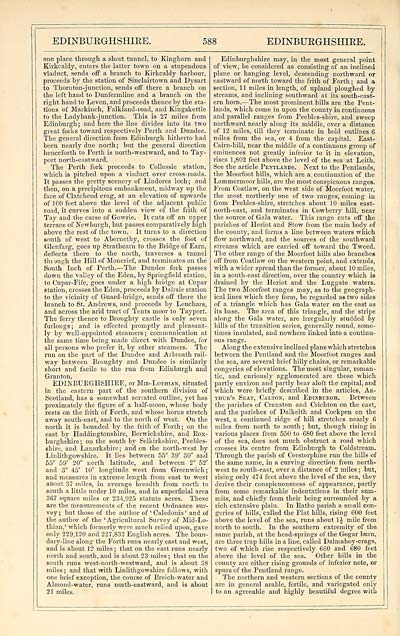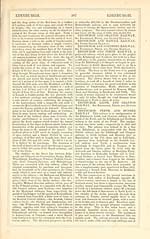Download files
Complete book:
Individual page:
Thumbnail gallery: Grid view | List view

EDINBURGHSHIRE.
588
EDINBURGHSHIRE.
one place through a short tunnel, to Kinghom and
Kirkcaldy, enters the latter town on a stupendous
viaduct, sends off a branch to Kirkcaldy harbour,
proceeds by the station of Sinclairtown and Dysart
to Thornton-junction, sends off there a branch on
the left hand to Dunfermline and a branch on the
right hand to Leven, and proceeds thence by the sta-
tions of Markinch, Falkland-road, and Kingskettle
to the Ladybank-junction. This is 27 miles from
Edinburgh; and here the line divides into its two
great forks toward respectively Perth and Dundee.
The general direction from Edinburgh hitherto had
been nearly due north ; but the general direction
henceforth to Perth is north-westward, and to Tay-
port north-eastward.
The Perth fork proceeds to Collessie station,
which is pitched upon a viaduct over cross-roads.
It passes the pretty scenery of Lindores loch; and
then, on a precipitous embankment, midway up the
face of Clatchend crag, at an elevation of upwards
of 1 CO feet above the level of the adjacent public
road, it curves into a sudden view of the frith of
Tay and the carse of Gowrie. It cuts off an upper
terrace of Newburgh, but passes comparatively high
above the rest of the town. It turns to a direction
south of west to Abemethy, crosses the foot of
Glenfarg, goes up Strathearn to the Bridge of Earn,
deflects there to the north, traverses a tunnel
thi img'h the Hill of Moncrief, and terminates on the
South Inch of Perth. — The Dundee fork passes
down the valley of the Eden, by Springfield station,
to Cupar-Fife, goes under a high bridge at Cupar
station, crosses the Eden, proceeds by Dairsie station
to the vicinity of Guard-bridge, sends off there the
branch to St. Andrews, and proceeds by Leuchars,
and across the arid tract of Tents moor to Tayport.
The ferry thence to Broughty castle is only seven
furlongs ; and is effected promptly and pleasant-
ly by well-appointed steamers; communication at
the same time being made direct with Dundee, for
all persons who prefer it, by other steamers. The
run on the part of the Dundee and Arbroath rail-
way between Broughty and Dundee is similarly
short and facile to the run from Edinburgh and
Granton.
EDINBURGHSHIRE, or Mid-Lothian, situated
in the eastern part of the southern division of
Scotland, has a somewhat seriated outline, yet has
proximately the figure of a half-moon, whose body
rests on the frith of Forth, and whose horns stretch
away south-east, and to the north of west. On the
north it is bounded by the frith of Forth ; on the
east by Haddingtonshire, Berwickshire, and Rox-
burghshire; on the south by Selkirkshire, Peebles-
shire, and Lanarkshire; and on the north-west by
Linlithgowshire. It lies between 55° 39' 30" and
55° 59' 20" north latitude, and between 2° 52'
and 3° 45' 10" longitude west from Greenwich;
and measures in extreme length from east to west
about 37 miles, in average breadth from north to
south a little under 10 miles, and in superficial area
367 square miles or 234,925 statute acres. These
are the measurements of the recent Ordnance sur-
vey; but those of the author of ' Caledonia' and of
the author of the 'Agricultural Survey of Mid-Lo-
thian,' which formerly were much relied upon, gave
only 229,120 and 227J832 English acres. The boun-
dary-line along the Forth runs nearly east and west,
and is about 12 miles; that on the east runs nearly
north and south, and is about 23 miles; that on the
south runs west-north-westward, and is about 38
miles; and that with Linlithgowshire follows, with
one brief exception, the course of Breich-water and
Almond-water, runs north-eastward, and is about
21 miles.
Edinburghshire may, in the most general point
of view, be considered as consisting of an inclined
plane or hanging level, descending northward or
eastward of north toward the frith of Forth ; and a
section, 11 miles in length, of upland ploughed by
streams, and inclining southward at its south-east-
ern horn. — The most prominent hills are the Pent-
lands, which come in upon the county in continuous
and parallel ranges from Peebles-shire, and sweep
northward nearly along its middle, over a distance
of 12 miles, till they terminate in bold outlines 6
miles from the sea, or 4 from the capital. East-
Cairn-hill, near the middle of a continuous group of
eminences not greatly inferior to it in elevation,
rises 1,802 feet above the level of the sea at Leith.
See the article Pentlands. Next to the Pentlands,
the Moorfoot hills, which are a. continuation of the
Lammermoor hills, are the most conspicuous ranges.
From Coatlaw, on the west side of Moorfoot water,
the most northerly one of two ranges, coming in
from Peebles-shire, stretches about 10 miles east-
north-east, and terminates in Cowberry hill, near
the source of Gala water. This range cuts off the
parishes of Heriot and Stow from the main body of
the county, and forms a line between waters which
flow northward, and the sources of the southward
streams which are carried off toward the Tweed.
The other range of the Moorfoot hills also branches
off from Coatlaw on the western point, and extends,
with a wider spread than the former, about 10 miles,
in a south-east direction, over the country which is
drained by the Heriot and the Luggate waters.
The two Moorfoot ranges may, as to the geograph-
ical lines which they form, be regarded as two sides
of a triangle which has Gala water on the east as
its base. The area of this triangle, and the stripe
along the Gala water, are irregularly studded by
hills of the transition series, generally round, some-
times insulated, and nowhere linked into a continu-
ous range.
Along the extensive inclined plane which stretches
between the Pentland and the Moorfoot ranges and
the sea, are several brief hilly chains, or remarkable
congeries of elevations. The most singular, roman-
tic, and curiously agglomerated are those which
partly environ and partly bear aloft the capital, and
which were briefly described in the articles, Ar-
thur's Seat, Calton, and Edinburgh. Between
the parishes of Cranston and Crichton on the east,
and the parishes of Dalkeith and Cockpen on the
west, a continued ridge of hill stretches nearly 6
miles from north to south ; but, though rising in
various places from 550 to 680 feet above the level
of the sea, does not much obstruct a road which
crosses its centre from Edinburgh to Coldstream.
Through the parish of Corstorphine run the hills of
the same name, in a curving direction from north-
west to south-east, over a distance of 2 miles ; but,
rising only 474 feet above the level of the sea, they
derive their conspicuousness of appearance, partly
from some remarkable indentations in their sum-
mits, and chiefly from their being surrounded by a
rich extensive plain. In Ratho parish a small con-
geries of hills, called the Plat hills, rising 600 feet
above the level of the sea, runs about 1A mile from
north to south. In the southern extremity of the
same parish, at the head-springs of the Gogar burn,
are three trap hills in a line, called Dalmahoy-crags,
two of which rise respectively 660 and 680 feet
above the level of the sea. Other hills in the
county are either rising grounds of inferior note, or
spurs of the Pentland range.
The northern and western sections of tho county
are in general arable, fertile, and variegated only
to an agreeable and highly beautiful degree with
588
EDINBURGHSHIRE.
one place through a short tunnel, to Kinghom and
Kirkcaldy, enters the latter town on a stupendous
viaduct, sends off a branch to Kirkcaldy harbour,
proceeds by the station of Sinclairtown and Dysart
to Thornton-junction, sends off there a branch on
the left hand to Dunfermline and a branch on the
right hand to Leven, and proceeds thence by the sta-
tions of Markinch, Falkland-road, and Kingskettle
to the Ladybank-junction. This is 27 miles from
Edinburgh; and here the line divides into its two
great forks toward respectively Perth and Dundee.
The general direction from Edinburgh hitherto had
been nearly due north ; but the general direction
henceforth to Perth is north-westward, and to Tay-
port north-eastward.
The Perth fork proceeds to Collessie station,
which is pitched upon a viaduct over cross-roads.
It passes the pretty scenery of Lindores loch; and
then, on a precipitous embankment, midway up the
face of Clatchend crag, at an elevation of upwards
of 1 CO feet above the level of the adjacent public
road, it curves into a sudden view of the frith of
Tay and the carse of Gowrie. It cuts off an upper
terrace of Newburgh, but passes comparatively high
above the rest of the town. It turns to a direction
south of west to Abemethy, crosses the foot of
Glenfarg, goes up Strathearn to the Bridge of Earn,
deflects there to the north, traverses a tunnel
thi img'h the Hill of Moncrief, and terminates on the
South Inch of Perth. — The Dundee fork passes
down the valley of the Eden, by Springfield station,
to Cupar-Fife, goes under a high bridge at Cupar
station, crosses the Eden, proceeds by Dairsie station
to the vicinity of Guard-bridge, sends off there the
branch to St. Andrews, and proceeds by Leuchars,
and across the arid tract of Tents moor to Tayport.
The ferry thence to Broughty castle is only seven
furlongs ; and is effected promptly and pleasant-
ly by well-appointed steamers; communication at
the same time being made direct with Dundee, for
all persons who prefer it, by other steamers. The
run on the part of the Dundee and Arbroath rail-
way between Broughty and Dundee is similarly
short and facile to the run from Edinburgh and
Granton.
EDINBURGHSHIRE, or Mid-Lothian, situated
in the eastern part of the southern division of
Scotland, has a somewhat seriated outline, yet has
proximately the figure of a half-moon, whose body
rests on the frith of Forth, and whose horns stretch
away south-east, and to the north of west. On the
north it is bounded by the frith of Forth ; on the
east by Haddingtonshire, Berwickshire, and Rox-
burghshire; on the south by Selkirkshire, Peebles-
shire, and Lanarkshire; and on the north-west by
Linlithgowshire. It lies between 55° 39' 30" and
55° 59' 20" north latitude, and between 2° 52'
and 3° 45' 10" longitude west from Greenwich;
and measures in extreme length from east to west
about 37 miles, in average breadth from north to
south a little under 10 miles, and in superficial area
367 square miles or 234,925 statute acres. These
are the measurements of the recent Ordnance sur-
vey; but those of the author of ' Caledonia' and of
the author of the 'Agricultural Survey of Mid-Lo-
thian,' which formerly were much relied upon, gave
only 229,120 and 227J832 English acres. The boun-
dary-line along the Forth runs nearly east and west,
and is about 12 miles; that on the east runs nearly
north and south, and is about 23 miles; that on the
south runs west-north-westward, and is about 38
miles; and that with Linlithgowshire follows, with
one brief exception, the course of Breich-water and
Almond-water, runs north-eastward, and is about
21 miles.
Edinburghshire may, in the most general point
of view, be considered as consisting of an inclined
plane or hanging level, descending northward or
eastward of north toward the frith of Forth ; and a
section, 11 miles in length, of upland ploughed by
streams, and inclining southward at its south-east-
ern horn. — The most prominent hills are the Pent-
lands, which come in upon the county in continuous
and parallel ranges from Peebles-shire, and sweep
northward nearly along its middle, over a distance
of 12 miles, till they terminate in bold outlines 6
miles from the sea, or 4 from the capital. East-
Cairn-hill, near the middle of a continuous group of
eminences not greatly inferior to it in elevation,
rises 1,802 feet above the level of the sea at Leith.
See the article Pentlands. Next to the Pentlands,
the Moorfoot hills, which are a. continuation of the
Lammermoor hills, are the most conspicuous ranges.
From Coatlaw, on the west side of Moorfoot water,
the most northerly one of two ranges, coming in
from Peebles-shire, stretches about 10 miles east-
north-east, and terminates in Cowberry hill, near
the source of Gala water. This range cuts off the
parishes of Heriot and Stow from the main body of
the county, and forms a line between waters which
flow northward, and the sources of the southward
streams which are carried off toward the Tweed.
The other range of the Moorfoot hills also branches
off from Coatlaw on the western point, and extends,
with a wider spread than the former, about 10 miles,
in a south-east direction, over the country which is
drained by the Heriot and the Luggate waters.
The two Moorfoot ranges may, as to the geograph-
ical lines which they form, be regarded as two sides
of a triangle which has Gala water on the east as
its base. The area of this triangle, and the stripe
along the Gala water, are irregularly studded by
hills of the transition series, generally round, some-
times insulated, and nowhere linked into a continu-
ous range.
Along the extensive inclined plane which stretches
between the Pentland and the Moorfoot ranges and
the sea, are several brief hilly chains, or remarkable
congeries of elevations. The most singular, roman-
tic, and curiously agglomerated are those which
partly environ and partly bear aloft the capital, and
which were briefly described in the articles, Ar-
thur's Seat, Calton, and Edinburgh. Between
the parishes of Cranston and Crichton on the east,
and the parishes of Dalkeith and Cockpen on the
west, a continued ridge of hill stretches nearly 6
miles from north to south ; but, though rising in
various places from 550 to 680 feet above the level
of the sea, does not much obstruct a road which
crosses its centre from Edinburgh to Coldstream.
Through the parish of Corstorphine run the hills of
the same name, in a curving direction from north-
west to south-east, over a distance of 2 miles ; but,
rising only 474 feet above the level of the sea, they
derive their conspicuousness of appearance, partly
from some remarkable indentations in their sum-
mits, and chiefly from their being surrounded by a
rich extensive plain. In Ratho parish a small con-
geries of hills, called the Plat hills, rising 600 feet
above the level of the sea, runs about 1A mile from
north to south. In the southern extremity of the
same parish, at the head-springs of the Gogar burn,
are three trap hills in a line, called Dalmahoy-crags,
two of which rise respectively 660 and 680 feet
above the level of the sea. Other hills in the
county are either rising grounds of inferior note, or
spurs of the Pentland range.
The northern and western sections of tho county
are in general arable, fertile, and variegated only
to an agreeable and highly beautiful degree with
Set display mode to: Large image | Transcription
Images and transcriptions on this page, including medium image downloads, may be used under the Creative Commons Attribution 4.0 International Licence unless otherwise stated. ![]()
| Gazetteers of Scotland, 1803-1901 > Imperial gazeteer of Scotland, or, Dictionary of Scottish topography > Volume 1 > (714) Page 588 |
|---|
| Permanent URL | https://digital.nls.uk/97467698 |
|---|
| Description | Volume I: Aan-Gordon. |
|---|---|
| Attribution and copyright: |
|

